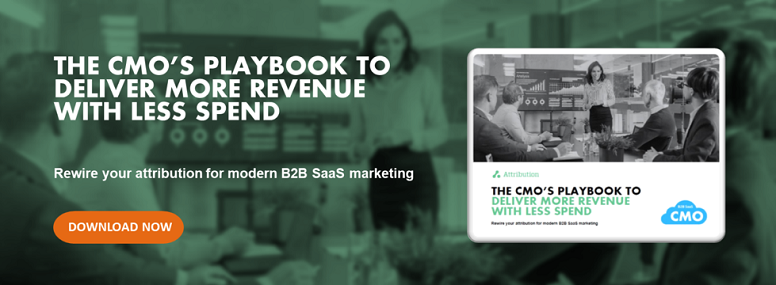Recent Posts
- How to Drive More Impactful Commerce Experiences with Shopify and Twilio Segment
- Why understanding the buyer’s journey is so important
- Revolutionizing Marketing Analytics! Announcing CallRail Integration with Attribution!
- Attribution Named High Performer in G2’s Spring 2024 reports for Attribution Software
- Optimize ROAS with Attribution’s enhanced integration with Segment
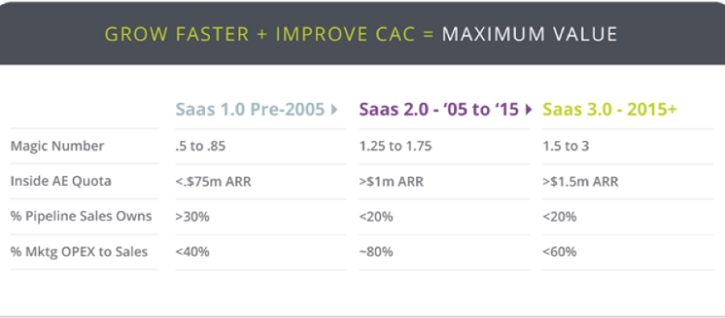
It’s Official: Multi-Touch Attribution Analytics Are Now the Smartest Weapon for B2B CMOs
By Ryan Koonce
The evidence that CMOs are on the hook for the magic growth number is overwhelming, but the days of unrestrained lead growth are fading into the annals of SaaS history. Inefficient scaling of a SaaS business is a death knell, which is why investors treasure the magic number as one of the best indicators of current health and future value. But without an effective and efficient marketing engine, the odds of a SaaS business scaling up growth and creating value are slim. And adding more salespeople only feeds the fire.
According to Paul Albright of Captora (Venture Beat), “The reality is the marketing has become THE most efficient want to accelerate growth in our digital economy. The imperative is to connect the dots, so each marketing expense dollar is aligned and reported against revenue growth.” Hence, CMO budgets are being conditioned by investors with weighty expectations to scale recurring revenue. The seminal question for CMOs is: How much recurring revenue are we getting out of your marketing? CMOs must own the answer to this question.
The Single Touch / Source Attribution Problem
How can you grow high-quality pipeline and bookings while improving the cost of acquiring new customers (CAC)? CMOs need to own the pathway to driving an impressive return on marketing and magic number. They own spending and outcomes for every marketing touch and channel across the full buyer’s journey from organic website clicks, social engagement and advertising click throughs to conference booth visits, nurture email downloads, on-demand demo views, and free trial requests.
While CMOs are on the hook for efficient revenue growth, the challenge is most are painfully handicapped by an archaic single-touch (or source) attribution approach. According to Chief Marketer’s Attribution Still a Huge Challenge for B2B Marketers report, “lengthy sales cycles, numerous touchpoints and too much data are among the biggest hurdles B2B marketers face when it comes to accurate attribution.” Regardless of how influential the other touches were in influencing the buyer, the first or last touch gets all the credit. How do you know which marketing touches and/or channels are really generating revenue and which ones need to go?
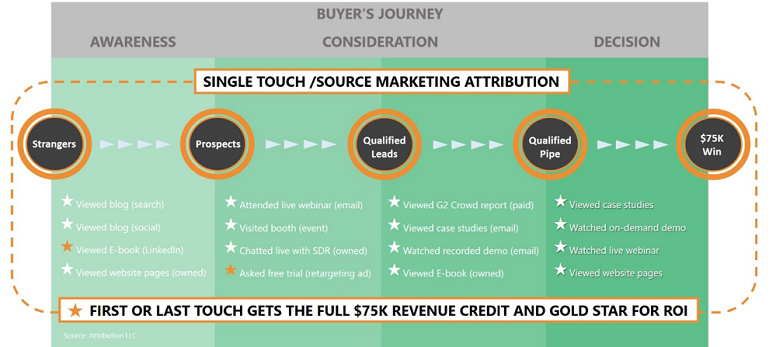
Single-touch attribution is inadequate for full-funnel, multi-touch insight. It does not tell you the impact of a given touch on revenue in relation to other touches nor does it give you the ROI granularity needed for optimization. This causes erroneous conclusions about what’s really working and what’s not. Further, single touch attribution involves multiple analytic tools and laborious effort, each one giving incomplete and biased insight. Single-touch attribution:
 Deceptively distorts revenue contribution and ROI of touches and channels by giving 100% credit to whichever touch was first or last, woefully understating the impact of other touches and channels such as events, content, or drip emails.
Deceptively distorts revenue contribution and ROI of touches and channels by giving 100% credit to whichever touch was first or last, woefully understating the impact of other touches and channels such as events, content, or drip emails.-
 Double-counts revenue credit from channel-specific sources such as Google Analytics and Facebook Insights each claiming 100% revenue credit of their respective touches to a deal, severely overstating ROI.
Double-counts revenue credit from channel-specific sources such as Google Analytics and Facebook Insights each claiming 100% revenue credit of their respective touches to a deal, severely overstating ROI.  Keeps you in a constant state of “attribution anarchy” due to stitching together attribution insights from your CRM, MAP, website, and channel specific sources, and spreadsheeting your way to getting the insight you need to optimize your spending.
Keeps you in a constant state of “attribution anarchy” due to stitching together attribution insights from your CRM, MAP, website, and channel specific sources, and spreadsheeting your way to getting the insight you need to optimize your spending. Negative Consequences: Relying on first or last touch marketing attribution to make decisions on spending adversely impacts scaling revenue growth and driving sales & marketing efficiency.
Negative Consequences: Relying on first or last touch marketing attribution to make decisions on spending adversely impacts scaling revenue growth and driving sales & marketing efficiency.
Modernizing Your Analytics with a Multi-Touch Attribution Platform That’s Wired for B2B Marketing
To solve this pervasive pain and give you and your organization the data you need to continuously optimize budgets and maximize revenue, you must change to an attribution approach that can deal with the rigors of modern B2B SaaS marketing.
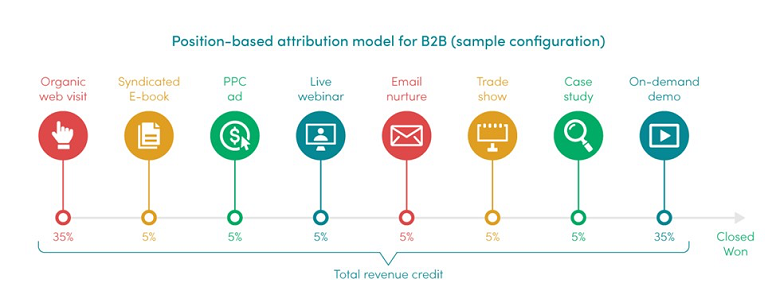
To start your journey, you will need to invest in a multi-touch attribution platform that:
- Automatically connects every marketing touch to your buyer’s full path to purchase. From anonymous website visits to email offer click-throughs, offline visits to an event or store to digital ad click-throughs.
- Uses various multi-touch attribution models such as time decay, linear, position-based and custom, depending on your business need. Regardless of source, channels, or funnel stage, these models must automatically allocate revenue and costs, and calculate ROI.
- Enables you to compare “apples-to-apples” ROI of any combination of channels over long buying journeys with the flexibility to group or cohort their revenue and cost results by date or other parameters.
- Provides built-in integration with:
– Popular B2B advertising platforms including LinkedIn, Google Ads, Quora, and AdRoll.
– Any other marketing channel including website, 3rd party media, offline events, content, and partners.
– Top B2B CRM and marketing automation platforms such as such as Salesforce, Pipedrive, HubSpot, and Marketo. - Tracks B2B account-level buying journey and automatically allocates credit for revenue, conversions, and cost to all account-based marketing efforts.
- Automatically reconciles touches and revenue credits among all your touch points to ensure 100% sum and zero duplicate to touches / channels that had no role in the conversion to revenue.
How Does Multi-Touch Attribution Fit in Your B2B Marketing Stack?
Multi-touch attribution doesn’t replace your CRM or MAP – it complements and enhances them. It enables both platforms to do what they do best: automate and scale lead and opportunity management activities. Multi-touch attribution also complements your advertising and other channels by integrating data flows and standardizing the attribution method, streamlining workflow and eliminating the chaos and inefficiency of extracting and normalizing data from multiple sources.
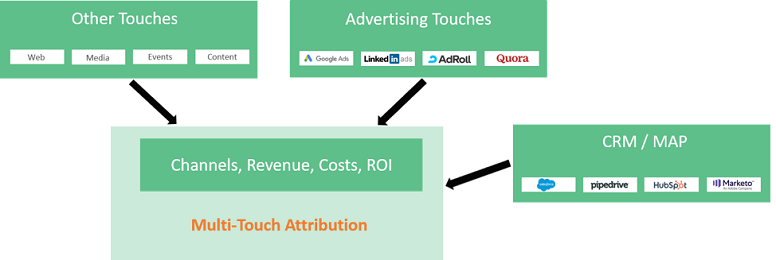
Concurrently, multi-touch attribution focuses solely on quantifying which marketing lead and opportunity activities (touches, campaigns, channels) are working (or not) to help marketers make better decisions across the entire (not just one touch or source) funnel. It also provides the data that fuels effective budgeting and optimization by helping marketers to know where to place their best bets to drive efficient revenue growth.
Your 4-Step Journey to Data-Driven Marketing
A multi-touch attribution cheat sheet for CMOs:
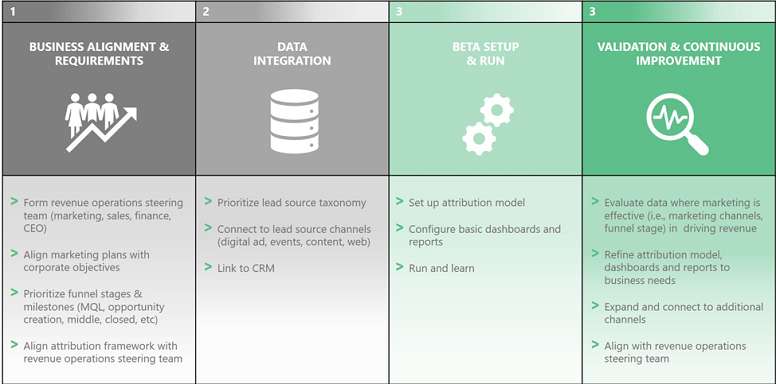
Marketing attribution has been re-thought for the modern, B2B SaaS marketing organization. Find out how you solve the pain of single touch / source attribution, giving you and your team the data to deliver more revenue with less spend:
